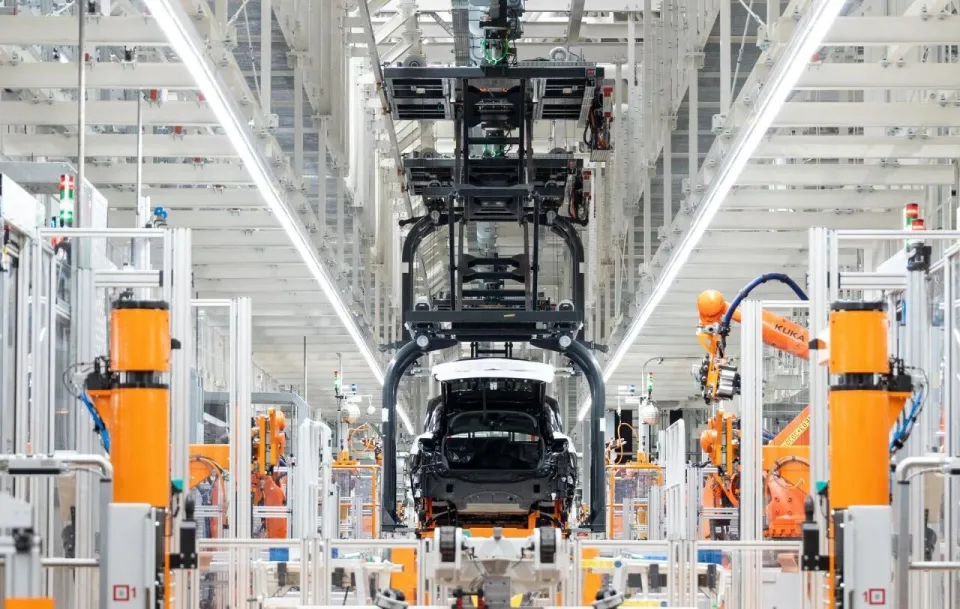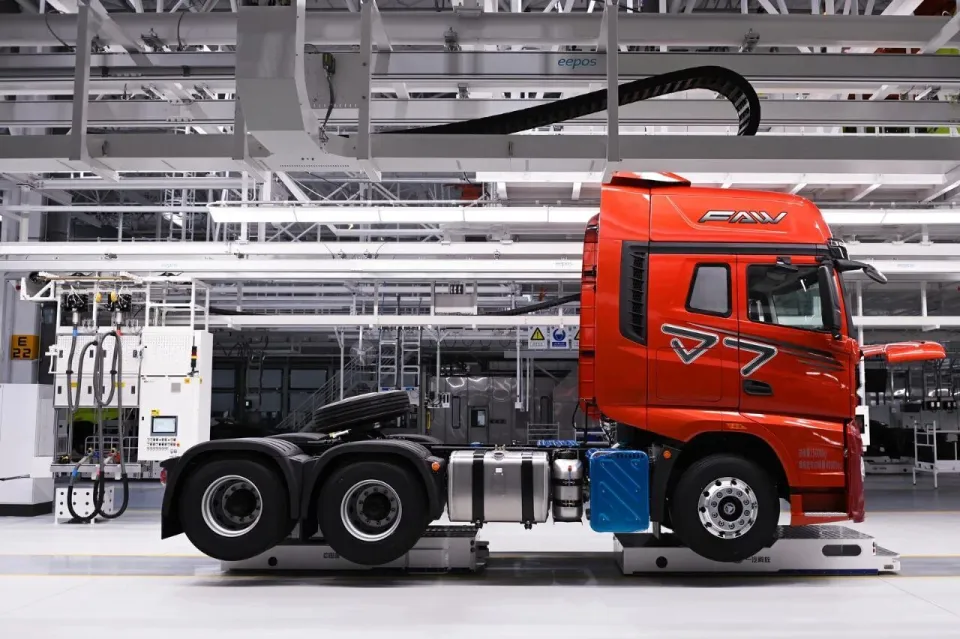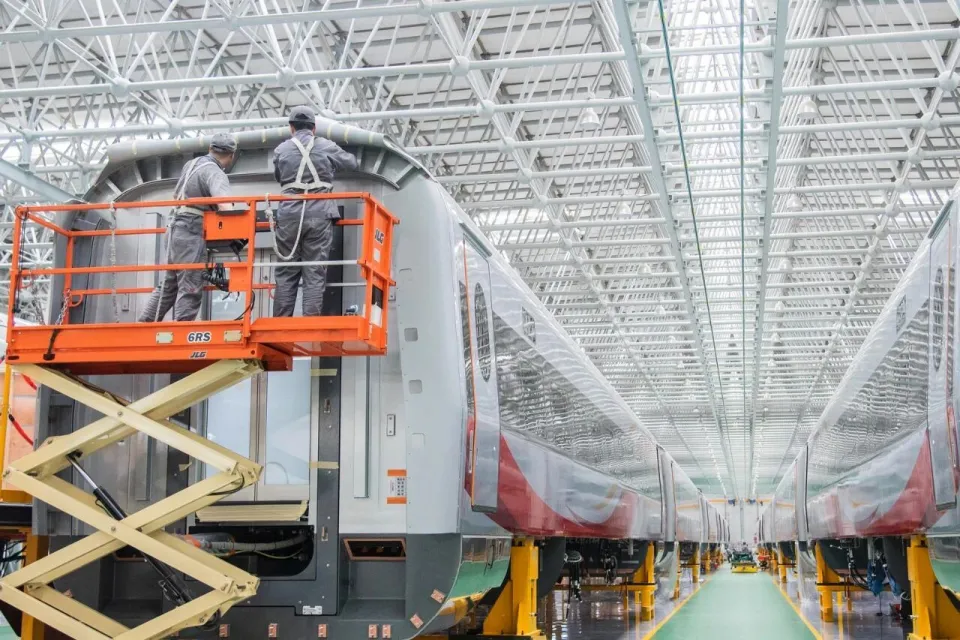Embracing Innovation, Intelligence, and the Future: Review of Changchun's High-Quality Industrial Development During the 14th Five-Year Plan Period
Over five years of persistent progress and leapfrog breakthroughs, Changchun has seen smarter machines, clustered factories, surging momentum, and projects advancing at full throttle. This fertile land that carries the industrial memory of the People's Republic of China has written a new chapter of high-quality development through an upward breakthrough of its industrial economy along the journey of the 14th Five-Year Plan.
The journey forward is far from smooth. Facing profound changes in domestic and international environments, Changchun's industry has taken "transformation" as its vessel and "innovation" as its oar, pressing ahead under pressure and finding new life amid challenges. A profound reform concerning structural optimization and energy transition is quietly unfolding in this old industrial base in Northeast China.
Over the past five years, Changchun's industrial strength has grown stronger and its "character" more refined. The transformation of its industrial landscape vividly demonstrates the essence of new industrialization. From the revitalization and upgrading of traditional industries to the accelerated development of emerging industries and the vigorous growth of future industries, a path of connotative and intensive development has become increasingly clear.
The industrial profile of the city shines ever brighter and newer—new in structure, momentum, and even in quality and efficiency.
Changes are evident along the trajectory of industrial development. During the 14th Five-Year Plan period, the dominance of a single industry has been quietly shifted. In 2024, the output value of the city's auto industry accounted for 58.3% of the total output value of industries above designated size, a decrease from previous years. Meanwhile, the combined output value of six other major industries exceeded RMB 315.33 billion, an increase of 35% from 2020.
Breakthroughs are evident along the rise of emerging industries. In 2024, the pharmaceutical industry achieved a year-on-year increase of 9.4% in output value, with an average annual growth rate of 13.1% over the past four years. The electronics industry saw a year-on-year increase of 7.4%, with an average annual growth rate of 12.4% over the past four years. The energy industry grew by 2.6% year-on-year, with an average annual growth rate of 7.8% over the past four years. A number of new quality productive forces are growing rapidly, becoming powerful engines propelling Changchun's industry toward medium and high-end development.
Embracing innovation, intelligence, and the future, Changchun is interpreting the contemporary significance of revitalizing Northeast China's old industrial bases through a deep industrial transformation and providing its answer to new industrialization.

Accelerating Auto Industry Upgrading Through Innovation and Sustainability
Industries thrive through innovation, gain strength through intelligence, and flourish through green development.
During the 14th Five-Year Plan period, this land imbued with an automotive heritage has leveraged the construction of a national advanced manufacturing cluster for the auto industry to orchestrate a "duet" of industrial chain collaboration and new track expansion. In 2024, Changchun's vehicle production and sales hit new highs, reaching 1.505 million and 1.499 million units, respectively. This included over 140,000 new energy vehicles produced and sold, underscoring the growing momentum of green energy in this "city on wheels" and marking a distinct feature of its industrial transformation.
A visit to the Hongqi Fanrong Plant reveals a world of intelligent manufacturing scenarios, where unmanned logistics vehicles shuttle flexibly along preset routes, production equipment transmits real-time operational data, and robotic arms perform welding and assembly with precision. Since its commissioning in October 2021, this modern base, recognized as a National Intelligent Manufacturing Pilot Plant, has become a vivid testament to "intelligent manufacturing in China". Hongqi has released two high-quality innovations—the Tiangong EV platform and the Jiuzhang intelligent platform—accelerating its sprint during the pivotal transformation toward new-energy and intelligent connected vehicles. FAW Jiefang continues to strengthen independent innovation, with its newly built high-end assembly line for the J7 models further reinforcing the backbone of domestic brands.

The successful implementation of major projects continues to expand the auto industrial chain's "circle of friends". The FAW-Audi New Energy Project, Audi's first electric vehicle production base in China, progresses rapidly. Its first Q6L e-tron series model officially hit the market in August 2025. With 50% of its suppliers planned within a 30-kilometer radius, the project has attracted numerous leading parts enterprises, forming a favorable pattern of "leading enterprises driving cluster development". The first phase of the FAW-FINDREAMS New Energy Power Battery Project, Northeast China's first NEV battery production base jointly built by FAW and BYD, was officially put into production in February 2024, filling the region's gap in automotive power battery manufacturing and strengthening a key link in the NEV industrial chain. In addition, major projects such as the FAW-CRRC Joint Venture Electric Drive System and the Phase II Fulscience Project were completed and put into operation, marking the preliminary establishment of Changchun's layout for NEVs, ICVs, and three electric systems.
The future vision of intelligent connectivity is rapidly becoming a reality. With the rapid development of the ICV industry, "vehicle-road-cloud integration", as a key pathway to intelligent transportation, is moving from concept to large-scale practice at an accelerated pace. Seizing the policy opportunity of being selected as one of the first national pilot cities for the ICV "vehicle-road-cloud integration" application, Changchun is vigorously developing typical demonstration application scenarios such as transportation hubs, urban roads, expressways, and highways to achieve efficient and coordinated development of vehicles, components, and aftermarket services. It is striving to drive the transformation and upgrading of its auto industry toward new energy and intelligent connectivity. Currently, the 23-kilometer testing and verification pilot zone in the Automobile Economic and Technological Development Zone and the Jingyuetan cultural tourism demonstration pilot zone have been established. Intelligent roads and demonstration scenarios are gradually bringing to life the vision of smart mobility where "vehicles can communicate, roads can think, and cloud-based systems can coordinate".

During the 14th Five-Year Plan period, multinational parts giants such as Magna, Lear, and Webasto have set up operations in the city, while domestic parts enterprises like FAWAY, FAWER, and FAWSN have grown robustly, and professional auto parts industrial parks have risen rapidly. As upstream and downstream enterprises gather at an accelerated pace and the industrial chain keeps improving, the "multiplier effect" of the auto parts cluster continues to amplify, strengthening the foundation for Changchun's auto industry to advance toward innovation, intelligence, and sustainability, and injecting continuous momentum into the revitalization of Northeast China's old industrial bases.

A Diversified and Synergistic Modern Industrial System Accelerates Its Formation
Only by steadfastly pursuing innovation can an industry achieve steady and sustained progress, and only by gathering momentum for leapfrog development can it secure a promising future. While leading the way in the auto industry, Changchun has been promoting coordinated development in multiple aspects. It is striving to build a modern industrial system with Changchun characteristics, featuring the "transformation of three traditional robust industries, advancement of four strategic emerging industries, and deployment of seven future industries", thereby reinforcing the fundamental pillars of its industrial development.
The optoelectronic information industry is striving to stay at the forefront of innovation. Leveraging its strong innovation capacity built through years of industry-university-research collaboration, Changchun is accelerating its pursuit of the "light". With a constant stream of new technologies and products, Changchun is achieving numerous "firsts" and "innovations". From launching four satellites at a time to launching forty-one, Chang Guang Satellite has built the world's largest sub-meter commercial remote sensing satellite constellation. Cedar Electronics has pioneered the development of small-pitch "LED Integrated Three-in-One" products. OLED Material Tech Co., Ltd. has established the largest display material production base in China. The high-throughput gene sequencer produced by GeOptics Sequencing Equipment Co., Ltd. boasts the highest throughput in the world. The wafer probe station produced by Guanghua Microelectronics is China's first commercial 12-inch full-automatic wafer probe station. The single-cell sorter developed by HOOKE INSTRUMENTS has enabled the industrialization of China's first single-cell sorting equipment…
In 2024, focusing on the five key fields of "chip, laser, satellite, vehicle, and network", Changchun's optoelectronic information industry achieved a total output value of RMB 90.02 billion, a year-on-year increase of 7.1%. A "100-billion-yuan-scale" industrial cluster is rapidly emerging.
The biomedicine and life health industries are exploring new frontiers. In Changchun, the biomedicine and life health industries are demonstrating remarkable vitality. Alphamab Oncology's denosumab injection has been approved for market launch, becoming the first monoclonal antibody product in Jilin Province. GenSci's recombinant human growth hormone accounts for 70% of the domestic market share. BCHT Biotechnology's "Influenza Vaccine, Live, Nasal, Freeze-dried" has been incorporated into the World Health Organization's Global Influenza Programme, while the company has also developed and produced China's first herpes zoster vaccine. SinoBiom's "PLLA Facial Filler" obtained Class III medical device registration, the first of its kind in China... Relying on the exemplary and leading role of leading enterprises, the foundation for developing the biomedicine and life health industries in the city has been continuously strengthened, facilitating breakthroughs and rapid growth in new products, technologies, and platforms. In 2024, the output value of the biomedicine and life health industries in the city reached RMB 110 billion, a year-on-year increase of 12.5%.

The high-end equipment sector has achieved continuous breakthroughs. In the high-end equipment sector, leading enterprises have been breaking through key core technologies, creating "crucial national equipment" and contributing "Changchun strength" to the high-quality development of China's equipment manufacturing industry. The Fuxing bullet train project won the Grand Prize of the National Scientific and Technological Progress Award. The "medium-low capacity vehicle" was recognized as a national single champion product in manufacturing (eighth batch). China's first hydrogen-powered urban rail vehicle successfully completed full-load running testing at a speed of 160 km/h. The prototype superconducting electrodynamic maglev vehicle was released. CRRC Changchun Railway Vehicles Co., Ltd. and Sinotest Equipment Co., Ltd. were named national single champion enterprises in manufacturing. In 2024, the output value of the city's high-end equipment industry reached RMB 55.11 billion, up 5.4% year-on-year.

Embracing new blue oceans such as optoelectronic information, biomedicine, and high-end equipment, Changchun's industrial landscape is unfolding with great momentum. Transitioning from "one industry leading the way" to "multiple industries advancing in parallel", from "traditional manufacturing" to "intelligent manufacturing", and from "large-scale expansion" to "pursuing quality and efficiency", Changchun's industry is forging ahead with a new posture on the path of high-quality development, writing an even more remarkable chapter in the comprehensive revitalization of Northeast China's old industrial bases.
Forging Manufacturing Advantages Through New Digital Intelligence Empowerment
From high-end equipment to precision chips and from construction machinery to new energy vehicles, Changchun's manufacturing industry has advanced steadily, accumulating strength for profound breakthroughs.
In industrial upgrading, one either forges ahead or falls behind. How can the city ensure that its manufacturing advantages remain strong? Changchun answers with intelligent transformation and digital upgrading.
For manufacturing enterprises technology-intensive ones, a major pain point is the inability to grasp production progress in real time. Digital transformation enables closed-loop management across basic data, sales, procurement, production, inventory, finance, and decision-making analysis, realizing integrated production operations. Information technology can help facilitate enterprises' digital transformation and upgrading.
The FAW Jiefang J7 Intelligent Factory stands as a prime example. Through the development of "automation, flexibility, digitalization, and intelligence", the factory has created a new model of "personalized customization, networked collaboration, and intelligent manufacturing". It has deeply integrated manufacturing and digital technologies, connected the three core data flows of orders, products, and manufacturing, and established an industry-leading digital and intelligent factory operation system. It now leads the industry in production operations, quality control, logistics distribution, energy management, and operation management, achieving optimal efficiency, effectiveness, and cost performance, significantly enhancing rapid manufacturing response capability, and fully meeting users' growing demand for diversified and personalized products. Compared to previous methods of obtaining on-site information through inspections, phone calls, or online work groups, the factory has reduced its operation workforce by 236 people, increased automation by 11%, and improved production efficiency by 11.4%.
Both "intelligent transformation" and "digital transformation" demonstrate Changchun's resolve to avoid rigidity and embrace innovation in manufacturing. In September 2023, the city was selected as one of the first national pilot cities for the digital transformation of small and medium-sized enterprises. By making full and effective use of national, provincial, and municipal policies, as of now, 1,460 industrial enterprises in the city have completed digital transformation. But with digital transformation comes questions: Will processes become more complex? Could there be issues of adaptability?
To address these concerns, the city formulated a scientific work plan for SME digital transformation, established a pilot enterprise database, and organized nearly 30 promotional activities like "county/district tours" and "industry tours" with industry experts and digital transformation service providers, attracting more than 1,500 participants. Over 1,000 "small, fast, light, and precise" digital products were selected and promoted. Focusing on the "new rich mine", the city has shifted from "digging coal" to "mining data", accelerating its rise as a center for the development of strategic emerging industries. More than 20 key enterprises and projects, including FAW's Fanrong 5G Plant, CRRC Changchun's Intelligent Manufacturing Demonstration Factory, the intelligent manufacturing solutions of MMI Planning & Engineering Institute IX Co., Ltd., and Qiming Information's innovative industrial Internet cases, have been selected as national model cases and scenarios for digital transformation. "Intelligent and digital transformation" has made enterprises more efficient, factories smarter, and the economic quality higher.
As the answer sheet for the 14th Five-Year Plan is being completed, the chapter on high-quality development continues to be written.
Five years of practice have proven that only by "embracing innovation" can bottlenecks be broken and advantages reshaped; only by "embracing intelligence" can tradition be revitalized and the future secured; and only by steadfastly "moving toward the future" can new possibilities be explored amid changes and opportunities nurtured amid challenges.
Embracing innovation, intelligence, and the future, Changchun's industrial vessel is embarking on a grander and brighter journey than ever before!
Source: Changchun Government Affairs Editor: Liu Jiadi



